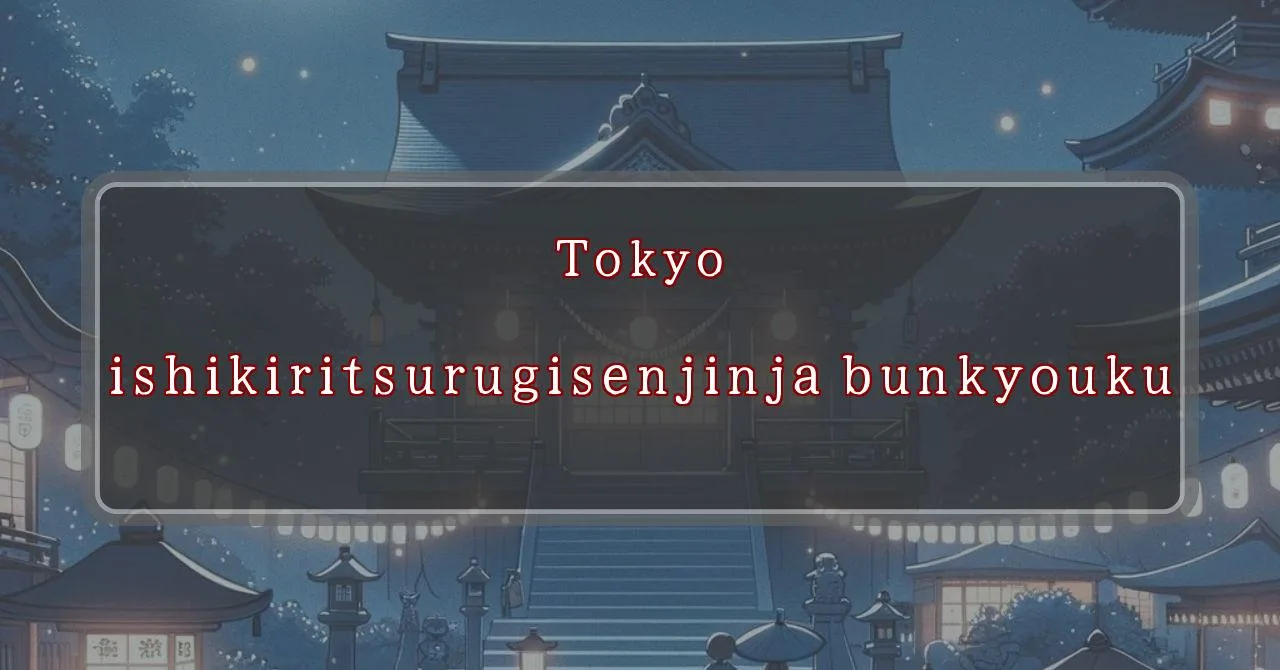Enchanting lights, divine blessings await
Basic Information
Discover the hidden power spot in the heart of Tokyo.
- Address: 1-9-10 Konodai, Bunkyo-ku, Tokyo
- Phone Number: 03-5978-0578
- Access: 8-minute walk from Edogawabashi Station on the Tokyo Metro Yurakucho Line, or a 14-minute walk from Myogadani Station on the Tokyo Metro Marunouchi Line
- Festival Days: 11th of every even-numbered month
Main Events and Attractions of the Festival
Immerse yourself in the vibrant atmosphere and rich traditions of the festival.
Kagura Performance
Witness the sacred Kagura dance performed by Shinto priests in the shrine’s Kagura殿 (hall). This traditional performing art combines music, dance, and storytelling to convey ancient myths and legends, offering a glimpse into Japan’s spiritual heritage.
Stalls and Delicacies
Explore the lively stalls lining the festival grounds, offering a variety of traditional Japanese food and local delicacies. From savory snacks to sweet treats, there’s something to satisfy every palate. Don’t miss the opportunity to sample some of the region’s specialties.
Benefits and Deities
The 石切剣箭神社 is renowned for its power to grant healing and recovery from illnesses. Devotees pray to the enshrined deities,饒速日尊 (Nigihayahi-no-Mikoto) and 可美真手命 (Umashimade-no-Mikoto), seeking their blessings for good health and well-being.
History and Origins
The 石切剣箭神社 has a rich history dating back to the Showa era. It was established in 1975 as a branch shrine of the renowned 石切劔箭神社 in Osaka, which is revered for its healing powers. The Tokyo branch shrine was built in response to the fervent wishes of local devotees seeking the same divine blessings.
Tips and注意事項 for Visitors
To ensure a safe and enjoyable visit to the festival, please take note of the following:
- The festival can be crowded, especially on weekends and holidays. Consider arriving early to avoid long lines.
- The shrine’s grounds are relatively small, so it may be challenging to navigate with strollers or wheelchairs.
- There is no dedicated parking lot for the shrine. Please use public transportation or nearby coin-operated parking lots.
Blessings and Deities
Discover the divine powers and enshrined deities of the 石切剣箭神社.
- 饒速日尊 (Nigihayahi-no-Mikoto): Revered as the deity of healing and recovery, Nigihayahi-no-Mikoto is the central figure worshipped at the shrine. Devotees pray to this deity for blessings of good health andmade-no-Mikoto is believed to bring blessings of love and harmonious relationships. Those seeking縁結び often visit the shrine to pray for a successful love life.
Origin and History
Explore the rich history and origins of the 石切剣箭神社.
- Establishment: The 石切剣箭神社 was established in 1975 as a branch shrine of the renowned 石切劔箭神社 in Osaka. The decision to build the Tokyo branch shrine was driven by the fervent wishes of local devotees seeking the same divine blessings and healing powers associated with the original shrine.
- Historical Significance: The 石切劔箭神社 in Osaka has a long and storied history, dating back to ancient times. It is believed to have been founded during the reign of Emperor Sujin, making it one of the oldest shrines in Japan. Over the centuries, the shrine has gained a reputation as a powerful spiritual center and a place of healing.
Tips and Notes for Visitors
Ensure a safe and enjoyable visit to the 石切剣箭神社 with these helpful tips.
- Crowds: The festival can attract large crowds, especially during weekends and holidays. To avoid long lines and ensure a more peaceful experience, consider visiting on a weekday or during less popular hours.
- Accessibility: The shrine’s grounds are relatively small and may not be easily accessible for visitors with strollers or wheelchairs. If you require assistance, it’s advisable to contact the shrine office in advance.
- Parking: There is no dedicated parking lot for the shrine. However, there are several coin-operated parking lots in the surrounding area. Please be prepared to walk a short distance from the parking lot to the shrine.
Parking Information
Find convenient parking options near the 石切剣箭神社.
- Coin-operated Parking Lots: There are several coin-operated parking lots located within walking distance of the shrine. These parking lots typically charge a fee per hour or per day. Please check the signage at each parking lot for specific rates and instructions.
- Public Transportation: The 石切剣箭神社 is easily accessible by public transportation. The nearest station is Edogawabashi Station on the Tokyo Metro Yurakucho Line. From the station, it is an 8-minute walk to the shrine. Alternatively, you can take the Tokyo Metro Marunouchi Line to Myogadani Station and walk for about 14 minutes to the shrine.
Popular Stalls and Food Carts in Recent Years
| Type of Stall | Description |
|---|---|
| Takoyaki | A staple at Japanese festivals. Characterized by a crispy outside and a creamy inside. |
| Jaga Butter | A simple yet popular snack of hot potatoes lavishly topped with melted butter. |
| Baby Castella | Small castella cakes, sweet and fluffy treats enjoyed by children and adults alike. |
| Grilled Ayu with Salt | Fresh ayu fish grilled whole with salt, a savory taste of Japanese summer. |
| Shaapin | A unique gourmet item influenced by foreign cuisine, with a chewy skin wrapping the filling. |
| Okonomiyaki | A Japanese grilled dish where you often choose your own ingredients for a personalized flavor. |
| Cotton Candy | A fluffy, sweet snack that’s extremely popular with children. |
| Chocolate Banana | A banana coated in chocolate, a fun and visually appealing dessert. |
| Kushiyaki | Various types of ingredients skewered and grilled, an easy-to-enjoy snack. |
| Yakisoba | Fried noodles mixed with a special sauce, a fast food favorite in Japan. |



